|
| |
|
Shaken, Not Stirred
by Bob Brooke
 Cocktail
shakers weren’t always elegant. The first shakers were hollowed out
gourds. Back in ancient Egypt and Mesopotamia they served to mix liquids
together and as such were a practical accessory for books back then. But
they lacked the style of 20th-century shakers. Cocktail
shakers weren’t always elegant. The first shakers were hollowed out
gourds. Back in ancient Egypt and Mesopotamia they served to mix liquids
together and as such were a practical accessory for books back then. But
they lacked the style of 20th-century shakers.
Collectible cocktail shakers arrived just after the invention of the
martini. However, there seems to be some controversy as to just when
that happened.
It isn’t known for certain who first mixed and served the first martini.
The best guess places this great event in late 19th-century America.
There are several theories as to its origin. One credits a bartender
named Jerry Thomas at San Francisco's Occidental Hotel in the 1860s with
mixing a special drink for a traveler bound for the nearby town of
Martinez. But for some reason, Thomas didn’t include the recipe for a
martini in America's first cocktail book, How to Mix Drinks, or The Bon
Vivant's Companion, that he first published in 1862, until the 1887
edition.
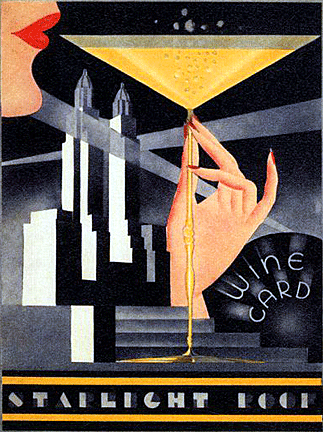 There
are those, however, who insist that the martini, consisting of equal
parts of gin and dry vermouth, was a New York invention, probably first
mixed at the Knickerbocker Hotel by bartender Martini di Arma di Taggia.
But if both sweet and dry vermouth were used, then the honor could
belong to William F. Mulhall, who served drinks of this sort at Hoffman
House, also in New York City, in the 1880s. There
are those, however, who insist that the martini, consisting of equal
parts of gin and dry vermouth, was a New York invention, probably first
mixed at the Knickerbocker Hotel by bartender Martini di Arma di Taggia.
But if both sweet and dry vermouth were used, then the honor could
belong to William F. Mulhall, who served drinks of this sort at Hoffman
House, also in New York City, in the 1880s.
Ever since those first concoctions, martinis have been a stylish drink,
appreciated not only for the kick they deliver, but also for the
accessories used in their preparation and enjoyment. The first recipe
calling for an accompanying olive can be traced to 1888, with the
v-shaped martini cocktail glass appearing early in the 20th century.
Bartenders who made early martinis either stirred the liquors together
or poured them from one glass to another to mingle them together.
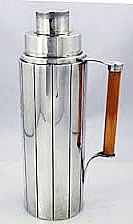 By
the time that Prohibition came to an end in 1933, people throughout the
nation enjoyed drinking martinis. Often viewed as the drink of
trendsetters and glamour seekers, martinis became associated with movie
stars, including William Powell and Myrna Loy. People at the time saw
martinis as very American, urbane, high-status, masculine, optimistic,
and adult— a drink for the wealthy and the powerful, or those aiming for
that status. By
the time that Prohibition came to an end in 1933, people throughout the
nation enjoyed drinking martinis. Often viewed as the drink of
trendsetters and glamour seekers, martinis became associated with movie
stars, including William Powell and Myrna Loy. People at the time saw
martinis as very American, urbane, high-status, masculine, optimistic,
and adult— a drink for the wealthy and the powerful, or those aiming for
that status.
As the 1930s gave way to the 1940s, the public image of martinis became
more sophisticated and accepted into wider circles: By the end of World
War II they had become identified as the drink of statesmen and
businessmen. The quest for the perfect dry martini was on.
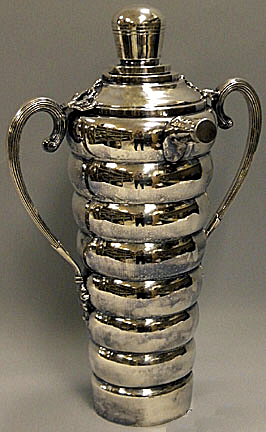 Wealthy
bon vivants of the 1920s shook theirs up in silver, while their less
affluent counterparts turned to glass or nickel-plated models. By the
following decade, mass- production made shakers a reality for those with
fewer means, manufacturing the shakers in chrome-plated stainless steel. Wealthy
bon vivants of the 1920s shook theirs up in silver, while their less
affluent counterparts turned to glass or nickel-plated models. By the
following decade, mass- production made shakers a reality for those with
fewer means, manufacturing the shakers in chrome-plated stainless steel.
Every maker of decorative home furnishings made cocktail shakers in the
1920s and 1930s, from Tiffany to aluminum manufacturers. While the Chase
Chrome Company, Revere Brass and Copper, and Farber Brothers were
leaders in the production of metal shakers, Hazel Atlas, Imperial,
Duncan Miller, and Cambridge Glass made them of glass.
Many shakers were made in Meriden, Connecticut., which became known as
"Silver City" and the home of many companies, including International
Silver, which manufactured metal ware serving wares.
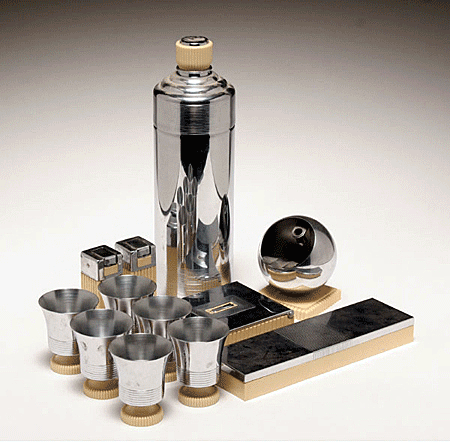 As
the demand for barware grew in the 1930s, the designs became more
varied. Makers produced sleek shakers from silver and silver-plate. Some
even sported Bakelite handles and trim. The shakers themselves featured
Art Deco designs, from airplanes to dirigibles, dumbbells to golf bags.
Some even took on the shapes of modern buildings. As
the demand for barware grew in the 1930s, the designs became more
varied. Makers produced sleek shakers from silver and silver-plate. Some
even sported Bakelite handles and trim. The shakers themselves featured
Art Deco designs, from airplanes to dirigibles, dumbbells to golf bags.
Some even took on the shapes of modern buildings.
Dubbed the "Manhattan Skyscraper serving set," one set, designed in 1936
by Norman Bel Geddes, is still considered to be among the most desirable
by collectors. For a somewhat less sophisticated clientele, shakers in
the shape of bowling pins were soon making their way into America's
liquor cabinets.
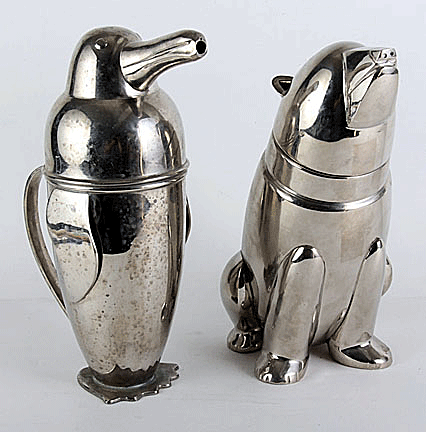 Among
famous makers, Napier produced a penguin in sterling circa 1936. Heisey
glass shakers boasted rooster or horse heads on the top. The ultimate in
decadence was reached when a shaker was fashioned in the shape of a
woman's leg; this ruby glass and chrome shaker appeared on the bar scene
in 1937. Glass shakers opened the possibilities for more design motifs:
enameled on the glass were bartenders, poodles, recipes, tuxedoes, and
what is now considered the most enticing of them all, pink elephants. Among
famous makers, Napier produced a penguin in sterling circa 1936. Heisey
glass shakers boasted rooster or horse heads on the top. The ultimate in
decadence was reached when a shaker was fashioned in the shape of a
woman's leg; this ruby glass and chrome shaker appeared on the bar scene
in 1937. Glass shakers opened the possibilities for more design motifs:
enameled on the glass were bartenders, poodles, recipes, tuxedoes, and
what is now considered the most enticing of them all, pink elephants.
Shakers were so important in some homes that furniture makers designed
special pieces to accommodate them, including bars, with special places
for glasses and trays, that had a special place to hold the martini
mixers.
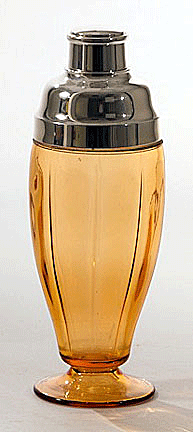 Generally,
martini shakers can be divided into three categories: the classic
shaker, the strained shaker, and the Boston shaker. The first known as a
classic shaker, made in three pieces—a metal tumbler, a snug-fitting
lid, and a small cap the fits over the spout and covers the internal
strainer. The second type dispenses with the use of a strainer and
consists of only two parts. The third type, called a "Boston shaker," is
a metal tumbler with a pint beer glass for the lid. Fastest to use, it
is commonly seen used by busy bartenders. With all of the variety of
materials, some purists insist that a shaker made in two parts of
stainless steel is the most efficient and durable. Generally,
martini shakers can be divided into three categories: the classic
shaker, the strained shaker, and the Boston shaker. The first known as a
classic shaker, made in three pieces—a metal tumbler, a snug-fitting
lid, and a small cap the fits over the spout and covers the internal
strainer. The second type dispenses with the use of a strainer and
consists of only two parts. The third type, called a "Boston shaker," is
a metal tumbler with a pint beer glass for the lid. Fastest to use, it
is commonly seen used by busy bartenders. With all of the variety of
materials, some purists insist that a shaker made in two parts of
stainless steel is the most efficient and durable.
The golden age of cocktail shaker design came to an abrupt end with the
beginning of World War II. Metals were earmarked for the production of
armaments, and cocktail shakers no longer seemed a priority to a country
at war.
While cocktail shakers can be found at garage sales, flea markets, and
thrift shops for under $10, the better designed ones can sell for four
or five figures.
In addition to auctions and antiques stores, beginning collectors can
easily find shakers in secondhand shops, and at yard sales and flea
markets. In fact, there’s no right or wrong way to collect cocktail
shakers. It's a matter of personal taste. There's one for every
budget—and taste. And vintage shakers were, after all, made to be used.
< Back to Collecting Archives
Next Article >
|
|

|
|
FOLLOW MY WEEKLY BLOG
Antiques Q&A
JOIN MY COLLECTION
Antiques and More
on Facebook
LIKE MY FACEBOOK PAGE
The Antiques
Almanac on Facebook |
|
No antiques or collectibles
are sold on this site.
|
|
How to Recognize and
Refinish Antiques for Pleasure and Profit
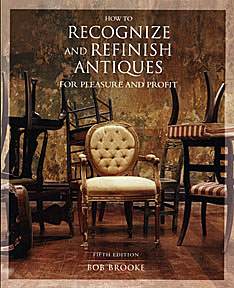
Have
you ever bought an antique or collectible that was less than perfect and
needed some TLC? Bob's new book offers tips and step-by- step
instructions for simple maintenance and restoration of common antiques.
Read an
Excerpt
|
|

|
|
|
|
|
